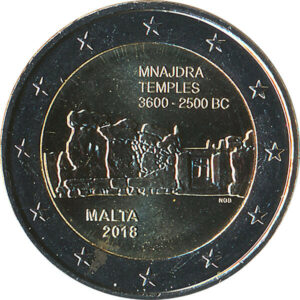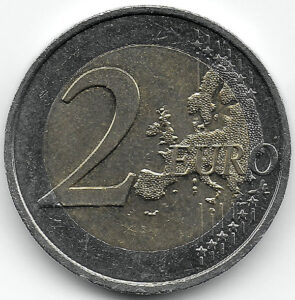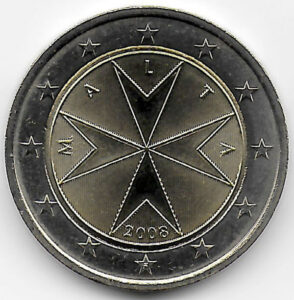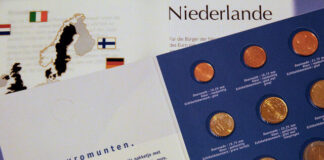
2 euro coins from the Republic of Malta are rarely found in circulation. If you do find a 2 euro circulation coin, you’ll immediately notice the characteristic Maltese cross. Almost all issues can be purchased in mint state from coin shops or online. As always, you should take your time to compare the offers before making a purchase. Here you can find an overview of some 2 euro commemorative coins from Malta that are likely to increase in value.
2 Euro Circulation Coins
The Republic of Malta did not introduce the euro as its sole currency until 2008. The reverse design (RV) meets the requirements set for all euro countries. The obverse (OBV) has featured the Maltese cross since 2008. Below there is the year and between the arms of the cross the country’s name MALTA. Since Malta doesn’t have its own mint, the first year (2008) was produced in France. You can see this from the “F” in the lowest star referring to the French mint. Later, other mints also produced coins for Malta. Some years are only available as special collector sets. Since the production of Maltese euro coins only started in 2008, there are no coins from Malta with the old reverse design of euro coins that had been in use until 2006.
Just like 2 euro commemorative coins, all 2 euro circulation coins consist of a ring made of cupronickel. The core is made of nickel brass with a nickel core (CuNi / Ni, CuNiZn plated). All pieces can slightly be attracted by a magnet at the centre.
Technical Specifications
- Weight: 8.50 g
- Diameter: 25.75 mm
- Reeded edge
- As an edge inscription, all coins from Malta feature six times an inverted “2” followed by two Maltese crosses in addition to the reeded edge.
Particularities
Coloured or even gilded pieces are not official issues. They have been doctored and lost their former value as currency. The first year minted in 2008 features the “F” for the French mint at the bottom of the euro star on the obverse. Some coins show a larger gap between ring and centre, this is no minting error but a mere coincidence. The same applies to coins where ring and centre seem to be slightly off-centred. Please note that regarding “actual” off-centre strikes, it is always the entire image and not just parts of the centre that are affected by the minting error.
Mint Error Coins
We know of coins with minor punching errors on both sides. There are only a few “actual” off-centre coins. Minor misalignments of ring and centre occur rather frequently and aren’t rarities! Furthermore, we know of weak strikes (for example regarding the stars). Nevertheless, watch out for die cracks and punching errors.
Appraisal
2 euro coins from Malta can rarely be found in circulation. Mint state specimens can be purchased on the secondary market for 5 to 8 euros. Prices for coins with punching errors on both sides start at 15 euros. The prices of “genuine” off-centre coins start at 70 euros. Weak strikes are worth between 10 and 20 euros, depending on the extent.
Joint Issues of the Eurozone
Since Malta introduced the euro in 2008, the country could only participate in the joint issues of the Eurozone from 2009, 2012 and 2015. So far, no mint error coins have been found. Attention! Malta’s edge design on the 2009 issue is the only one that deviates from the usual design. Instead of the Maltese crosses, two stars were depicted. These issues aren’t error coins! These pieces are hardly ever found in circulation. On the secondary market, prices for mint state specimens range from 7 to 10 euros. But once again: coloured or gilded pieces are not official issues. They have been doctored and lost their former value as currency.
Technical Specifications
The technical specifications correspond to those of a 2 euro circulation coin.

History of the Constitution of Malta, 2014
In the Floriana Park of the capital Valletta you can find the Independence Monument of Malta. The bronze statue symbolizes that Malta has been independent since 1964. The obverse shows the upper part of the monument. A woman with the national flag in her hand symbolizes Malta. The legend on the right reads “MALTA – Independence 1964”. Below the year 2014.
Technical Specifications
The technical specifications correspond to those of a 2 euro circulation coin.
Particularities
Coloured or even gilded pieces are not official issues. They have been doctored and lost their former value as currency. There are pieces with a mint master mark on the bottom of the rim. These pieces weren’t intended for circulation, they are from coin sets that were produced for collectors.
Mint Error Coins
So far, no mint error coins have been found. Nevertheless, keep looking for minor punching errors, die cracks and rotated die error coins.
Appraisal
These coins can hardly be found in circulation. On the secondary market, prices for mint state specimens start at 6 euros.

Prehistoric Sites of Malta – Mnajdra Temples, 2018
In the southwest of Malta you can find an impressive ensemble of temples from prehistoric times. The temples have been considered a UNESCO World Heritage Site since 1992. A stylized form of the Mnajdra Temples can also be seen on Malta’s 1 to 5 cent coins.
Technical Specifications
The technical specifications correspond to those of a 2 euro circulation coin.
Particularities
Coloured or even gilded pieces are not official issues. They have been doctored and lost their former value as currency. Pieces with an “F” on the lower star weren’t intended for circulation, they are from coin sets that were produced for collectors.
Mint Error Coins
So far, no mint error coins have been found.
Appraisal
These coins can hardly be found in circulation. On the secondary market, prices for mint state specimens range between 5 and 12 euros.

Prehistoric Sites of Malta – Skorba Temples, 2020
The Skorba Temples are among the megalithic temples of Malta that have been considered UNESCO World Heritage Sites since 1992. Next to the temple complex on the bottom right, the image shows a female clay figure that was found in 1963.
Technical Specifications
The technical specifications correspond to those of a 2 euro circulation coin.
Particularities
Coloured or even gilded pieces are not official issues. They have been doctored and lost their former value as currency. The mintage figure of 150,000 specimens was not particularly large regarding normal issues intended for circulation. Prices are likely to increase. Pieces with an “F” on the lower star and pieces with cornucopia (Monnaie de Paris) as well as the mark of the chief engraver in Paris next to the year weren’t intended for circulation; they are from coin cards or sets that were specially produced for collectors.
Mint Error Coins
So far, no mint error coins have been found. Nevertheless, keep looking for minor punching errors, die cracks and rotated die error coins.
Appraisal
These coins can hardly be found in circulation. On the secondary market, prices for mint state specimens range between 12 and 20 euros.
In the online database Cosmos of Collectibles you can find all 2 euro coins of Malta.
Don’t miss any new coin issues! Subscribe to the Cosmos of Collectibles newsletter for free.
The author numiscontrol has already dealt with the rarities among 2 euro commemorative coins of other countries. too. Here you can read his articles on coins from
- Luxembourg
- Italy
- France and
- Ireland.
And here you can find his series on rare 2 euro pieces from Germany and on the joint EU issues (in German).
Find out more about our author numiscontrol, alias Reiner Graff, in our who’s who.
The collecting expert made it his mission to introduce beginners to the world of coin collecting – here you can read his series “Coin Care in Simple Terms”.






